

Cogenra Solar. Photovoltaics market booming in US; 1.7GW installed in first six months. According to the latest report form IMS Research, PV installations in the US in the first half of the year have reached 1.7GW, a growth of over 120%, compared to the same period a year ago.

With utility-scale projects typically back-end loaded, the market research firm expects installations in the Americas to reach nearly 4.3GW in 2012. “The Americas market, led by the USA was unseasonably strong in the first half and did not show any significant slowdown resulting from the anti-dumping duties,” noted Ash Sharma, IMS Research PV Research Director. As a result of the massive increase in US demand, the country is expected to become the third largest PV market in 2012, accounting for 40% of new capacity growth. “IMS Research remains optimistic about the potential for the US PV market, and we predict it will grow to at least 3.5 GW in 2012 and become the world’s third largest PV market. Parabolic trough. Artificial photosynthesis. A sample of a photoelectric cell in a lab environment.
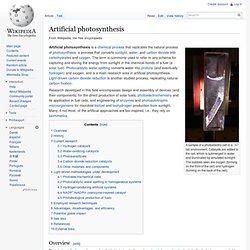
The economics of solar power - McKinsey Quarterly - Energy, Resources, Materials - Strategy & Analysis. For trade visitors. For the first time, Clean Energy Expo Asia is co-located with Energy Efficiency Asia and Carbon Forum Asia to provide a dedicated platform for policy makers and industry practitioners to address key issues, develop business opportunities and discuss practical solutions towards securing Asia’s energy future.
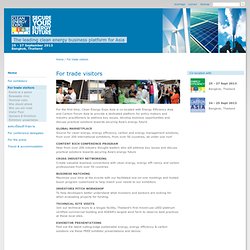
GLOBAL MARKETPLACESource for clean energy, energy efficiency, carbon and energy management solutions, from over 200 international exhibitors, from over 50 countries, all under one roof. CONTENT RICH CONFERENCE PROGRAMHear from over 200 industry thought leaders who will address key issues and discuss practical solutions towards securing Asia’s energy future CROSS INDUSTRY NETWORKINGCreate valuable business connections with clean energy, energy effi ciency and carbon professionals from over 50 countries BUSINESS MATCHINGMaximize your time at the events with our facilitated one-on-one meetings and hosted buyer program customized to help match your needs to our exhibitors.
GmbH - Parabolic Trough Power Plants. Solarthermische Anlagen bieten die nachhaltigste Form der Energiegewinnung in Bezug auf Umwelt, Ressourcen und Verfügbarkeit.

Die Technologie hat den Vorteil, dass mit höherer direkter Sonneneinstrahlung auch der Wirkungsgrad der Anlagen steigt. Solar panel made with ion cannon is cheap enough to challenge fossil fuels. Twin Creeks, a solar power startup that emerged from hiding today, has developed a way of creating photovoltaic cells that are half the price of today’s cheapest cells, and thus within reach of challenging the fossil fuel hegemony.
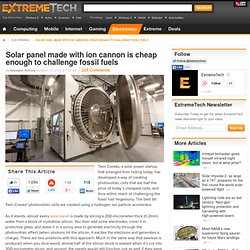
The best bit: Twin Creeks’ photovoltaic cells are created using a hydrogen ion particle accelerator. Robot-Installed Solar Panels Cut Costs by 50% Solar panels are obeying the will of Moore's Law by getting ever cheaper and more efficient.

What's not getting cheaper or more efficient is the human labor required to install them. This keeps the cost of going solar higher than us duck-squeezing envirinmintl types would like, but robots are busy coming to our rescue by setting up solar power plants much cheaper and much, much faster. Here's the executive summary, since I've never done an executive summary before and it sounds fancy: using robots to set up a 14 megawatt solar power plant can potentially cuts costs from $2,000,000 to $900,000, while being constructed in eight times faster with only three human workers instead of 35. So long, silicon: Researchers create solar panels from cheap copper oxide. Researchers from the University of California and Berkeley Lab have discovered a way of making photovoltaic cells out of any semiconducting material, not just beautiful, expensive crystals of silicon.
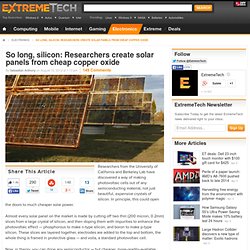
In principle, this could open the doors to much cheaper solar power. Almost every solar panel on the market is made by cutting off two thin (200 micron, 0.2mm) slices from a large crystal of silicon, and then doping them with impurities to enhance the photovoltaic effect — phosphorous to make n-type silicon, and boron to make p-type silicon. These slices are layered together, electrodes are added to the top and bottom, the whole thing is framed in protective glass — and voila, a standard photovoltaic cell. Meet the Guy Whose Tech Will Transform Solar Power...and He's Giving it Away. Cool Earth Solar: Reshaping Solar Energy.
Price per watt. See also: Cost of electricity by source for a comparison of prices per watt by generation source Price per watt, or $/W is a common way to compare the capital costs of various forms of electricity generation.
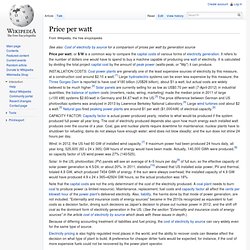
It refers to the number of dollars one would have to spend to buy a machine capable of producing one watt of electricity. Watt-peak. The nominal power of a photovoltaic (PV) module is determined by measuring in an electric circuit the current and voltage while varying the resistance under precisely defined illumination.
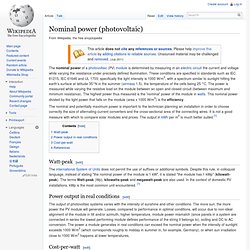
These conditions are specified in standards such as IEC 61215, IEC 61646 and UL 1703; specifically the light intensity is 1000 W/m2, with a spectrum similar to sunlight hitting the earth's surface at latitude 35°N in the summer (airmass 1.5), the temperature of the cells being 25 °C. Balance of system.